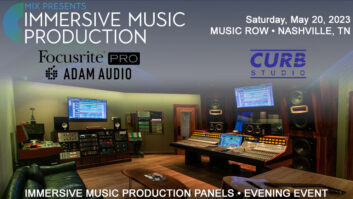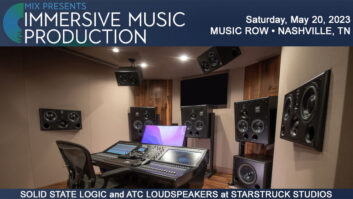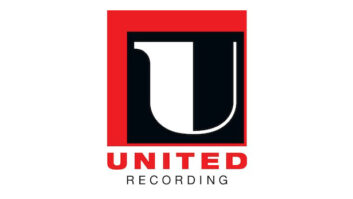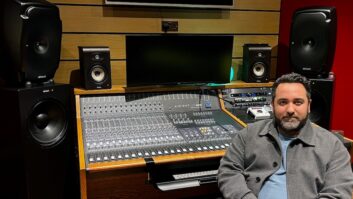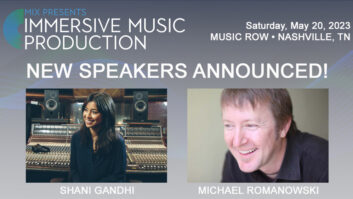Napoleon once disparaged the English as “a nation of shopkeepers,” and the London studio industry is increasingly a business of small boutiques, often allied with larger established facilities. The renaissance that London studios have enjoyed in the past five years, as bands like Blur and Oasis have rejuvenated the big-sound rock record sector in music, is drawing to a close. Now, the focus is shifting to project studios, and the observations of commercial studio managers and owners show that many are feeling the pinch.
“It’s been up and down lately, the last year-and-a-half,” says Ian Davidson, director of Virgin Studios, which includes London’s Olympic Studios and The Town House facilities. “The fortunes of big studios like these follow the course of the music business, and the band thing has been giving way a bit to more techno-pop from Europe, which doesn’t have the same needs for big rooms as rock music does. ultimately, that affects the studios’ bottom line.”
Managing three music rooms at Olympic and four at The Town House (which also has five audio post-production suites), Davidson has found that he’s been unable to raise rates, which average u1,100 per 12-hour day (about $1,760 u.S.), despite having upgraded each of the facilities with an SSL 9000 J console. Olympic and The Town House are able to add to their margins by strictly enforcing 12-hour days and charging higher rates for overtime, and by charging separately for certain key pieces of digital equipment, such as Sony 3348 digital multitrack recorders. The three trucks of the company’s mobile recording company, Manor Mobile, are also high-margin revenue generators; with only four people assigned specifically to the division, the trucks have a lower overhead than the studio and can often charge higher rates.
As techno music makes a comeback, productions move into smaller, more private spaces. But veterans like Davidson have been around long enough to know that this process is cyclical, and that bands and the need for large recording spaces will return at some point, which makes it worthwhile to keep facilities as close to the technological edge as is affordable.
Olympic and The Town House might seem to have the resources of Virgin founder Richard Branson as a cushion, but Davidson stresses that “the studios are expected to make their own way financially.” One of the creative solutions Davidson has developed to keep these studios successful is to rent parts of the facilities, of various sizes, to engineers and producers. The studios benefit both from the rental income and the proximity to tenants’ larger budget projects. The Town House has five such tenants, Olympic another four, each renting the equivalent of a small (12×12-foot) office for the equivalent of nearly $20,000 per year. Most tenants have converted the rooms into personal studios. (One example is Spike Stent’s studio at Olympic. See “The Project Studio,” page 118.)
“They get the benefits of a larger facility, such as security, reception and catering,” says Davidson of his engineer/producer tenants. In addition, Davidson says the ability to work in a professional environment dovetails nicely with the experience many independent producers and engineers have had in terms of a desire to move out of their residences, for space, family and other reasons. “Many of them have outgrown their personal studio situations,” he says.
George Martin’s AIR Studios also leases project rooms to producers and engineers. “The client will provide most of their own equipment but benefits from the studio’s 24-hour technical service and other facilities,” explains Alison Burton, AIR’s sales and operations manager. Those facilities, of course, include AIR’s four impressive studios: The breathtaking Lyndhurst Hall with its 72-channel Neve VRP Legend console, the 72-channel custom Neve/Focusrite-equipped Studio 1, Studio 2 with its SSL 8000 G board and the AMS Neve Logic 2 in Studio 3.
“We have found that as the trend for producers and engineers to work with Pro Tools, etc., in small home or project studios grows,” Burton continues, “leasing rooms for this purpose creates a symbiotic relationship with our more commercial rooms. Once the client has finished pre-production of a track, the transition into a larger tracking or mix room within the building complex is obviously an attractive prospect.” Presently, AIR leases rooms to composer/producer David Arnold, who recently completed recording the score for The World Is Not Enough, and to producer/writers John Halliday and Trevor Steele.
Roundhouse Studios lays claim to having pioneered this particular brand of studio/client synergy. Roundhouse added dedicated client rental suites when the 20-year-old facility moved several years ago. The studio effectively redefined itself to match the direction in which music in the uK then appeared to be moving-from a few large studios to a larger number of smaller ones. Maddy Clarke, Roundhouse’s studio manager, concedes that there are pitfalls for those who try to anticipate and accommodate shifting trends in the music industry. After designing the new facility with smaller recording spaces but larger control rooms, Clarke says, “It was frustrating, a few years back, when all of a sudden everyone wanted big recording spaces again. But we’ve done well at attracting MIDI and mixing clients with the arrangements we have.”
Roundhouse also continues to let out seven programming suites to production tenants, though that market has become more competitive as more programming suites have opened in London. “When we first did it, it was a clever way to boost revenues to the studio,” says Clarke. “It wasn’t a cheap investment-we built the rooms to very high standards, with lounges and overdub spaces. We spent about u300,000 at the time. But once it was recouped, it was a very good source of income. But now every Tom, Dick and Harry has done this, and there’s a lot of rooms on the market. When two of our clients left-one to go on tour and the other moving to the States-where once we had a waiting list to get in now we found we had to shop the rooms around.” Despite an increasing inventory of available rooms, Clarke and other studio managers indicate that there are now more potential renters than before, an illustration of how deep the pool of independent producers and engineers has become.
Over at Abbey Road, the famous facility has just entered into its first relationship of this sort, having just leased a programming room to a producer. However, the studio’s director of operations, Chris Buchanan, says that this facility is the exception that proves the rule that band recording has waned. “Abbey Road is known for its large acoustic rooms, and those are still busy,” he says. “But Abbey Road isn’t typical, of course, as we work with such a wide range of projects, such as film scoring, musicals, classical and pop bands, plus mastering, remastering and, more recently, multimedia. I think to survive in the future, studios will need to be pretty flexible and make the most of all their assets.”
Stanley House, a two-year-old, $2 million independent music facility in the Stanley Gardens district of London, was also designed to address the same market opportunity. Co-owner Andy Morris (who, with his partner Ian Devaney had helped guide Lisa Stansfield’s first two albums to sales of 10 million copies) had his seven programming rooms open before the main SSL 9000 J-outfitted studio came online last year. Most of the programming rooms are now rented to producers and engineers, with minimum six-month leases, and tenants include producer Jon Douglas (George Michael, All Saints) and remixers the Dirty Rotten Scoundrels. Morris says his tenants have drawn such artists as George Michael, Bjork and Connor Reeves into the studio for sessions.
In addition to proximity to the main studio, the programming rooms also share the 7,000-square-foot building’s other amenities, which include a private pub on the fourth floor. At a time when conventional studios are having a hard time competing with personal facilities, the advantage of being able to order a pint of lager after the horrifically early official 11 p.m. closing time of most London pubs was one that Morris latched onto early in his business plan. “It’s as much a social thing as it is professional,” Morris explains. “People naturally want to be around other people who do what they do, and that works in our favor in terms of providing that as a service to producers and engineers.”
But even beer sales contribute to the bottom line these days. Morris concedes that the relatively new main room has been slow getting off the ground, and he has had to reduce rates once since it opened. He’s also noticed that the mix of artists has moved toward dance, R&B and techno, which helps explain why, though the main studio has a mid-sized tracking space, most of the calls he gets for it are for mix projects. When all of his revenue sources are factored in, Morris says business is “decent,” but a long-planned second studio remains on the drawing board, and he is more inclined at present to consider adding more rentable suites to the facility. He has, however, added a new Pro Tools system, which has become the most common interface between the increasingly distinct camps of conventional and personal studios in London.
ARTISTS IN RESIDENCELondon has always had a fairly robust fringe of studios on its outskirts, and at Ridge Farm Studio in Surrey, an hour west of London, owner Frank Andrews is hoping that he can change with the times, despite the studio’s location on a 350-year-old farm. Like many of his American counterparts, Andrews points to the impact on recording budgets and studio choices that has resulted from corporate downsizing in the uK entertainment industry. “I see more projects going back to direct recording as opposed to acoustical spaces, and most of what we do here on analog eventually ends up on hard disk anyway,” Andrews observes.
During the past two years, under the supervision of studio manager Ann Needam, the studio has begun managing several producers and engineers as a way to both derive revenues from commissions and to build alliances between people and the facility. That effort is still secondary to Ridge Farm’s core business, but Andrews says it’s too early to tell if that will remain the case several years hence. Meanwhile, he’s also hedging his bets with a line of esoteric analog signal processing units, and he expects to double the line from two to four products by the beginning of the year.
All of this is necessary to supplement the studio’s revenues, says Andrews. In an interview two years ago, he commented that the resurgence of bands and the upturn in uK record sales, which had increased 14% in 1996, had prompted a round of upgrades throughout London’s studio community. Ridge Farm installed an SSL 9000 J and other gear during that period of optimism. As Andrews said at the time, in a verbal snapshot that contrasts with the current climate, “There’s a level of confidence out there in the music industry that hasn’t been seen since before the recession a few years ago. [Record companies] are investing in music again.” Andrews is a veteran and has seen this cycle repeat itself several times, and he fully expects it will again. “But in the meantime, you can’t wait for it,” he says. “Things will change, but they never revert to whence they came. So we have to change our focus to accommodate that.”
OTHER APPROACHESAlthough the music scene is in continual flux, there are a few studios that haven’t had to deviate from their traditional mode of studio operations. Angel Recording’s two very large rooms have found a strong and steady niche in London’s orchestral market, which has lately been on an upswing driven by several factors: growth in classical music CD sales, more film and television scoring, cast albums from London’s robust theater scene and a demand for more lush string parts on pop records. Studio manager Gloria Luck says while Angel has not been able to increase its rate of u1,350 per day for its rooms, it hasn’t had to retreat on them either, and she hopes to be able to increase rates sometime this year. “It’s been strong even while the record companies have been cutting back a bit on pop records,” says Luck.
Metropolis is one of the largest facilities in London, with five main recording studios and several mastering suites. Managing director Laura Traill concedes that revenues from music bookings are harder to predict now than two years ago, and she has taken a more proactive approach. Metropolis has installed a dedicated 5.1 mixing studio fitted with an SSL 9000 J console. Traill markets it to record labels as part of a new division, Metropolis DVD, which is headed up by David Anthony, founder of New York authoring studio Zuma Digital.
“I certainly wouldn’t say we’re overbooked in that room as yet,” Traill says. “But what we are doing is approaching the record labels and suggesting that they give us the stereo mixes of some of their larger artists and letting us show them what we can do with it. We need to show this client base the potential of the format. We’re trying to grow that market instead of waiting for it to come to us.”
Metropolis has also created a central booking system for all of its operations. The company expanded its mastering operation dramatically in 1998 when Metropolis acquired u.S. mastering facility Sterling Sound in New York, creating a trans-Atlantic joint venture. (Traill also acknowledged that Metropolis is still actively looking for other possible acquisitions which would, says Traill, “complement our core businesses.”) As part of that reorganization, Metropolis has been presenting its clients with various rate and operational formulae that encourage them to use more of the facility’s capabilities, from pre-production in two programming suites, through mixing, mastering and post-production services. Following the model that’s been in place at certain large u.S. facilities for about a year, clients can get lower overall rates the more Metropolis services they use. “What it comes down to is that studios simply have to be more creative in how they package themselves and their services to their clients,” says Traill.
Another company following the mergers and acquisitions model is Sanctuary Group. A multifaceted, publicly traded company, Sanctuary derives about a third of its annual u22 million revenues from music recording, with record production and music management (Pet Shop Boys and Iron Maiden are management clients) and children’s television programming making up the balance. The music recording division has become extremely active since Bernie Spratt took over its operations in late 1998, and it has acquired several new studio and mobile properties, including Nomis Studios, Classic Sound and Fleetwood Mobile, bringing the total number of facilities under its umbrella to eight.
Spratt is a 25-year studio business veteran who was with Chop Em Out until the mastering facility was acquired by Sanctuary Group. Spratt says that the recording division is aggressive in marketing its services widely, and that less than 10% of its revenues comes from within its own group of artists. “Recording studios are now like commodities, and you can’t just go out and buy a big console and sit by the phone and wait for it to ring,” he observes. Rather, he says, he’s steering Sanctuary back to the service model based on staff engineers. “People, and the quality of the staff you provide, are better at differentiating studios in a commodity business environment than consoles are,” he says.
SURROUND-OR LACK THEREOFLondon isn’t yet seeing any significant demand for multichannel audio. The overall DVD consumer video format was rolled out in Europe a year after its 1998 introduction in the u.S., and, though the DVD-Audio specification released earlier this year is putatively global, and the Philips/Sony SACD format has been seen in Continental studios recently, multichannel audio has simply not generated the same degree of interest-or equipment buying-that it has in the States.
Nonetheless, several studios, including Abbey Road, Metropolis and Sarm, have put in dedicated surround monitoring systems in anticipation of demand. Bill Ward, technical manager for Sarm, says a 5.1 monitoring array was included as part of a larger refitting of one of the facility’s studios. “We don’t know if the market is going to be there, but we’ll be ready for it if it is,” he says.
Others are holding off. “We’ve had a couple of requests, but no real demand yet,” says Davidson of Virgin Studios. Davidson, like other facility managers, has bought additional speakers and amplifiers but has not yet committed to a dedicated 5.1 monitoring installation, preferring to set the gear up when it’s requested. Virgin’s studios don’t charge higher rates for surround monitoring or mixing, but Davidson will charge for setup time of the additional speakers. Ridge Farm’s Andrews expresses the feelings of many other London studio owners when he says, “There’s no demand for it, and we don’t need another round of upgrades right now.”
Nevertheless, London is possibly poised for another round of upgrades. Since techno-based music has been a big component of the music business there for more than a decade, studios have been watching hard disk systems passing through their doors, but many have been reluctant to commit to specific systems. Now, say several studios, the market has apparently made its choice. “up until recently, we and other studios had been essentially catering the studios to what clients were bringing in,” says Sarm’s Ward. “The RADAR systems did well initially-people liked their portability. But Pro Tools did well with their plug-ins, and it appears that Pro Tools is winning the market here. That’s the system we’ve decided to go with.”
Ward adds that, whereas hard disk systems were once used mainly by dance and techno clients and rock clients generally preferred analog, the technology is no longer a reflection of the music. Although analog remains strong, Ward notes that hard disk systems are being used by a wider range of music clients.
Large-format digital consoles have not taken off as quickly in the UK as in the U.S., a function of studio economics as much as anything else, says Ward. However, Manor Mobile has the UK’s lone SSL M-T, and Abbey Road and CTS (which does mainly music for film and TV) have Neve Capricorn consoles. “In the four studio control rooms that we have,” says Abbey Road’s Buchanan, “three are analog and one is digital. That’s probably about right for now. For mixing, so much good, easy-to-use outboard gear is still analog, so it’s more convenient to stick with an analog desk.”
“We have been one of the pioneers of all-digital consoles, being the first studio in the world to have a Neve DSP console back in 1984,” says Peter Fielder, general manager at CTS. “We have subsequently continued our involvement with digital consoles by installing an AMS Neve Capricorn in 1995, and that has provided its reliability and some commercial success. However, in the uK, digital consoles have not yet made the breakthrough into the major studio market due to a number of factors, such as operational unfamiliarity, cost, and perceived unreliability. The sound of digital audio is still perceived to be inferior to analog. However, the market for more cost-effective digital consoles, such as Yamaha or Mackie, is growing mainly because the advantages of flexibility that digital can offer appeal to that marketplace, and the prices are more attractive.”
“Large-format digital consoles are making much slower progress into the purely music recording market than originally anticipated,” agrees AIR Studios’ technical manager, Tim Vine-Lott. “This is primarily because engineers don’t like the way they sound, and secondly because of the ergonomics of the control surfaces offered. They have made more significant inroads in classical recording, TV and film post-production where the automation and reset capabilities make them invaluable.”
Sarm has two Euphonix CS2000 hybrid consoles-one owned by resident producer Trevor Horn-but Ward says the studio will wait a bit longer before choosing an all-digital console. “The concept of digital recording has been embraced for some time now, but the idea of digital consoles is still not quite there,” he says. “I expect that to change in the next year or so. What I find interesting is that as much digital recording that has gone on in London over the years, you’d think that that would have propelled the idea of digital desks. But it hasn’t. I think studio owners were concerned about being able to sell the rooms with them.”
